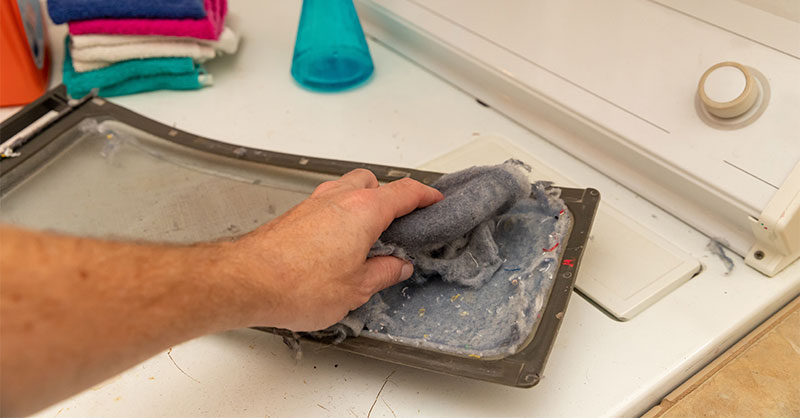Best Practices for Laundry Fire and Water Damage

Clean the lint filter before or after each use to reduce the risk of fire caused by accumulated dust and lint.
Clothes Dryers
According to the U.S Fire Administration, an estimated 2,900 clothes dryer fires in residential buildings are reported to U.S. fire departments each year, causing approximately:
- 5 deaths;
- 100 injuries; and
- $35 million in property loss.1
What may be the most concerning part is that most of these fires could have been prevented by practicing good housekeeping behaviors.
Causes of Fires
The U.S. Fire Administration performed a study spanning from 2008 to 2010, that analyzed data from clothes dryer fires in residential buildings. Below are some of the results of their research:
Table 5. Leading Specific Items First Ignited in Clothes Dryer Fires in Residential Buildings (2008-2010)
| Item First Ignited | Percent (Unknown Appointed) |
|---|---|
| Dust, fiber, lint | 27.6 |
| Clothing not on person | 27.2 |
| Other soft goods, wearing apparel or clothing | 8.8 |
| Appliance housing or casing | 7.5 |
| Linen other than bedding | 6.0 |
| Electrical wire, cable insulation | 5.7 |
Source: NFIRS 5.0
This data shows that dust, fiber, lint and clothing accounted for over half of ignition sources in these fires.1
Table 4. Factors Contributing to Ignition in Clothes Dryer Fires in Residential Buildings by Major Category (Where Factors Contributing to Ignition are Specified, 2008-2010)
| Factors Contributing to Ignition Category | Percent of Clothes Dryer Fires in residential Buildings (Unknown Appointed) |
|---|---|
| Operational deficiency | 46.6 |
| Mechanical failure, malfunction | 28.6 |
| Electrical failure, malfunction | 15.6 |
| Misuse of material or product | 9.5 |
| Design, manufacture, installation deficiency | 4.0 |
| Other factors contributing to ignition | 3.3 |
| Natural condition | 0.6 |
| Fire spread or control | 0.2 |
Source: NFIRS 5.0
Notes:
- Includes only incidents where factors that contributed to the ignition of the fire were specified.
- Multiple factors contributing to fire ignition may be noted for each incident; total will exceed 100 percent.
- Operational deficiency can be defined as operating the appliance incorrectly, or the failure to clear lint traps on a regular and ongoing basis.1
When lint traps are not cleaned as often as they should, and vent systems are not checked and cleaned regularly, airflow is reduced due to lint buildup in the screen or other areas around the dryer. This can cause the dryer to perform poorly, operate at elevated temperatures and possibly overheat.
Problems can also occur if improper items are placed in dryers, such as foam-backed rugs or athletic shoes. Additionally, issues can arise if appliances are ventilated with plastic, vinyl or aluminum foil exhaust materials.
One Simple Solution
To achieve optimal airflow and reduce lint buildup, an all-metal dryer vent or duct is recommended. Rigid or flexible metal venting and ducting materials help sustain airflow and reduce operating costs, while extending the life of the dryer and clothing, due to lower drying temperatures.
Additional Dryer Safety Tips
- Clean the lint filter in the dryer before or after each use to reduce the risk of fire caused by accumulated dust and lint. Also, remove accumulated lint around the drum and from the back of the dryer, where lint can be trapped.
- Ensure that the dryer is plugged into an outlet suitable for its electrical needs.
- Do not operate the dryer without a lint filter.
- Make sure that the air exhaust vent pipe is not restricted, and that the outdoor vent flap will open when the dryer is operating. If you notice the drying time is longer, clean the vent system thoroughly to ensure proper airflow.
- Do not leave the dryer running if you go out because if it malfunctions, no one would be there to avert a possible disaster.
- Keep the dryer area clear of combustibles, like boxes and clothing.
- Have your dryer installed and serviced by a professional.
Washing Machines
Washing machines are a significant source of water damage or flood damage in homes and institutions where they are used. In fact, washing machine hose failures cause about $150 million in damage in the United States and Canada each year.2
To reduce the chances that your hoses could fail, the following precautions should be taken:
- Install braided stainless steel hoses. They are much less susceptible to bursting than ordinary washer hoses.
- Inspect your washing machine hoses regularly.
- Install water hammer arrestors to further reduce the chance of washing machine hoses breaking. A water hammer arrestor can absorb the increased water pressure that comes when the electric valve in your washing machine shuts off.
- Secure the drain hose so it will not flip out of the drain hole.
- Turn off the water supply to the washing machine when it is not in use.
References
1Clothes Dryer Fires in Residential Buildings (2008–2010). (2012). U.S. Fire Administration.
Retrieved from https://www.usfa.fema.gov/downloads/pdf/statistics/v13i7.pdf.
2Time to Replace Your Washing Machine Hoses? (2014). Bow Mar Water and Sanitation District.
Retrieved from
http://www.bowmarwater.org/page.cfm/ID/797/iNewsID/391









